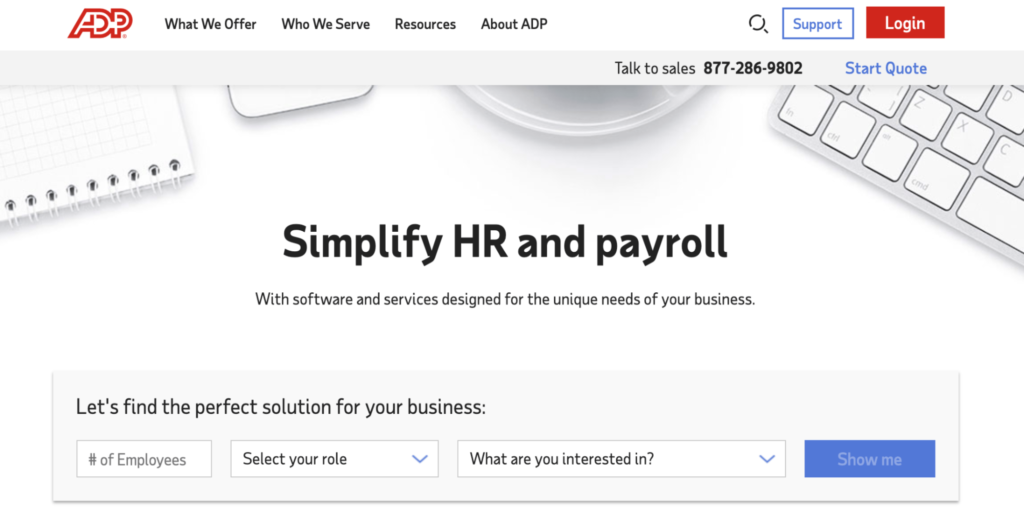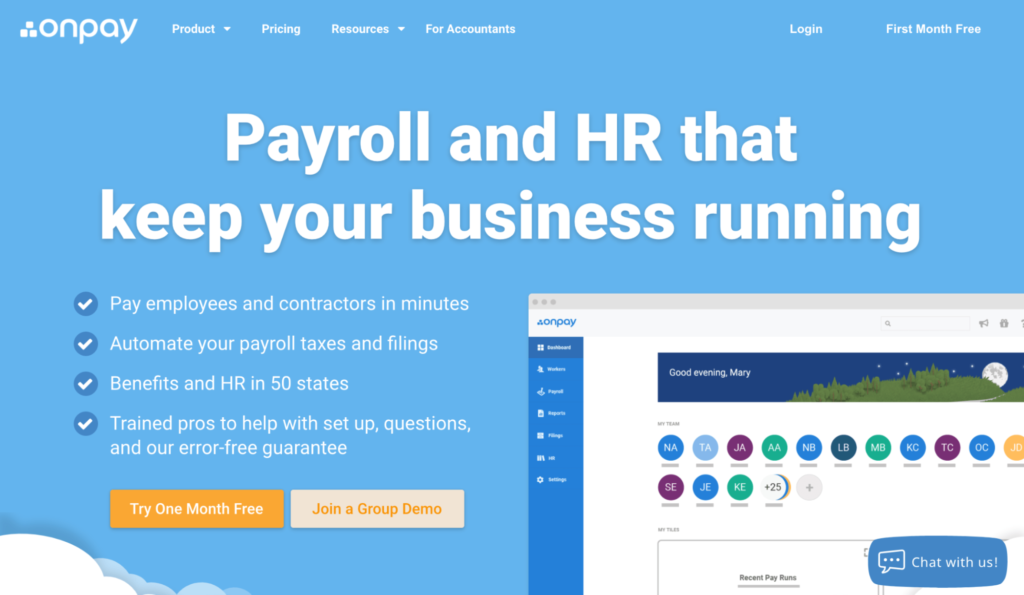Businesses are required to pay lots of different taxes. In addition to income tax and sometimes sales tax, you’re also responsible for payroll tax.
Lots of business owners don’t understand how payroll tax works, which can lead to compliance issues and hefty fines—especially if you’re trying to calculate these taxes on your own.
In addition to paying the different payroll taxes, you’ll also need to file reports with the appropriate state, local, and federal government agencies.
If you’re lost and need help understanding how payroll tax works, this guide is for you.
What is Payroll Tax?
Payroll tax is imposed by state, federal, and local governments to fund various programs. The taxes come from employer and employee wage withholdings.
A certain percentage of pay from an employee’s wages, salary, and tips are withheld from paychecks. It’s the employer’s responsibility to calculate the withholdings and pay the taxes to the appropriate government agency on the employee’s behalf.
Some payroll taxes are split evenly by employees and employers—the employer will match the employee’s contribution for each payroll cycle.
The Basics of Payroll Tax
Let’s take a closer look at the different types of payroll taxes and how they work. The following sections will help you understand payroll tax at a higher level.
Federal Insurance Contribution Act (FICA)
FICA is split into two parts for payroll tax—Social Security and Medicare.
Employees and employers alike must pay this tax, and the total cost is split evenly between both parties.
The Social Security tax rate is 6.2% of an employee’s compensation, up to a limit ($137,700 in 2020 and $142,800 in 2021). The Medicare portion is taxed at a rate of 1.45%. This means employees pay 7.65% of their wages towards FICA taxes, and employers match the amount for a total of 15.3%.
Unlike Social Security taxes, there is no limit to Medicare taxes. In fact, employees making over $200,000 per year may have to pay an additional Medicare tax of 0.9%, and employers aren’t required to match this portion.
So where exactly is the money going?
The Social Security tax goes towards OASDI, better known as Old Age, Survivors, and Disability Insurance. It provides benefits to disabled individuals, retirees, and dependents.
Medicare taxes go towards the Hospital Insurance Trust Fund and the Supplementary Medical Insurance Trust Fund. Essentially, these funds help pay for Medicare—federal health insurance designed for people over the age of 65 and other people with disabilities. It covers things like hospital care, nursing care, x-rays, lab tests, ambulance services, and more.
Federal Unemployment Tax Act (FUTA)
Employees who have been involuntarily terminated from employment have access to unemployment benefits. While the federal government doesn’t pay for these benefits, they provide assistance to states in need of funding for unemployment pay.
This assistance comes from FUTA—the Federal Unemployment Tax Act.
FUTA taxes are only applied to the first $7,000 of compensation to each employee. The standard FUTA tax rate is 6%.
Most employers can receive a 5.4% credit, bringing the net FUTA tax rate down to 0.6%. This credit comes when it’s time to file Form 940.
State Unemployment Tax Act (SUTA)
In addition to FUTA, most states impose unemployment taxes as well. It’s the state’s responsibility to pay unemployment benefits to certain eligible workers—and they fund this liability using payroll taxes.
Each state has unique rules and rates for this tax. Some of these state taxes are better for employees, while others are better for businesses.
For states with unemployment tax, the concept is fairly straightforward. Taxes are imposed on businesses based on the claims rate. If a business has lots of former employees filing for unemployment benefits, the tax rate imposed on that business will be higher.
In essence, state unemployment taxes can be compared to insurance. Fewer claims translate to lower rates.
Income Tax Withholding
Income tax withholding is designed to cover what employees will owe for the year on income taxes.
Rather than paying the full amount of taxes when it’s time to file, a portion of the tax is withheld from each paycheck and sent to the appropriate government agency by the employer. Federal income taxes and state income taxes both fall into this category, based on the employee’s location.
Tax withholding is a legal requirement, but some employees have control over how much is withheld from their paychecks—assuming they meet certain criteria.
Depositing and Filing Payroll Tax
Depending on the business, FICA taxes are usually paid on a monthly or semi-weekly basis. It’s common for FUTA taxes to get paid quarterly.
For both instances, employers can use the Electronic Federal Tax Payment System for deposits.
In addition to the actual deposits, businesses are responsible for reporting how much payroll taxes they withheld throughout the year. The frequency of the reports is typically done on a quarterly basis. But some businesses with a smaller tax liability might be able to report these payroll taxes annually.
In terms of state and local tax deposits and filing, the procedures vary from state to state.
Self Employment Payroll Taxes
Sole proprietors, freelancers, contractors, businesses operating as a partnership, and anyone else who is self-employed still need to pay payroll taxes—even if they’re not technically running payroll.
Let’s say you’re an independent contractor running a solo operation. If your net earnings are more than $400 for the year, you’re required to pay self-employment taxes.
In this scenario, you’re responsible for paying both the employer and employee’s contribution of FICA—a total of 15.3% tax on your net earnings from self-employment.
5 Tools to Help With Payroll Tax
Payroll taxes can be difficult to calculate on your own. But using modern payroll software can really make your life much easier.
#1 — Gusto

More than 100,000 businesses rely on Gusto for payroll. It’s a simple way for small business owners to manage payroll, and employees benefit from lots of great self-service tools. I like Gusto because the software automatically calculates and files payroll taxes on your behalf.
Using Gusto is a breeze. It only takes a few minutes to run your payroll. After the initial setup, you can put your payroll runs on autopilot without having to worry about calculating taxes or filing with the right government agency—all of this is automated. Plans start at just $45 per month.
#2 — ADP Payroll

ADP is an industry leader in the payroll and HR software space. The company has been around for 70+ years, and they offer online payroll solutions to businesses of all sizes. Whether you’re looking for payroll basics or a fully integrated solution with enhanced HR support, automation, talent acquisition, and more, ADP has an option for you.
The software is designed to be fast and accurate. It’s easy to set up and sync deductions to ensure accuracy for all federal, state, and local taxes. ADP also provides you with detailed reports to help you understand your payroll and taxes at a higher level. New hires will automatically be reported to state agencies as well. Contact ADP for a custom quote.
#3 — Paychex

Paychex is another well-known and reputable name in the payroll software space. You can use the software to run payroll in just a few simple clicks. Paychex offers employee self-service tools, customizable earnings and deductions, advanced reports, multiple payment options, and so much more.
The payroll tax services from Paychex really make this solution stand out from the crowd. Everything is automated, including pay calculations, tax calculations, and tax filings with the appropriate government agencies. Paychex will even make sure that your business gets any tax credits that you’ve earned. Request a demo and free quote to get started.
#4 — OnPay

OnPay is a great option for small businesses and companies with remote employees. With simple, all-inclusive pricing starting at just $36 plus $4 per employee per month, it’s one of the most affordable online payroll systems on the market. Your first month using OnPay is free, and they don’t charge any setup fees.
You can use OnPay to run payroll and pay employees in multiple states. The software automatically calculates withholdings, payroll taxes, and files everything with the right agency. OnPay automatically files W-2s and 1099s as well. For a simple way to take control of running payroll and managing payroll taxes, OnPay must be taken into consideration.
#5 — QuickBooks Payroll
QuickBooks is best known for its accounting software. But the software provider has a wide range of other business solutions as well, including QuickBooks Payroll. The payroll packages start at just $22.50 plus $4 per employee per month.
It’s a simple way to run fast and accurate payrolls every cycle. Like other tools on our list, QuickBooks automatically calculates, files, and pays payroll taxes for you. But QuickBooks takes this one step further with a tax penalty protection benefit. If there’s an error and you receive a payroll tax penalty, QuickBooks will cover the fees, up to $25,000.
3 Tricks For Payroll Tax
As you’ve seen from what we’ve covered so far, payroll tax can be complicated. But these quick tricks will save you time, money and help you avoid compliance issues.
Trick #1: Automate Payroll Taxes
Manually calculating payroll tax is a cumbersome process. Not only will it take lots of time, but it’s also subject to human error.
Improperly calculating, paying, and filing payroll taxes can lead to problems for your business. You could be subject to fines or penalties for underpaying taxes to the IRS or state agencies. But you could also land yourself in hot water for labor compliance if you’re taking too much money from employee paychecks for taxes.
To avoid this, look for an online payroll solution that will automatically calculate payroll taxes. Lots of solutions will automatically file reports to the appropriate government agencies on your behalf as well, so you won’t have to worry about a thing.
Trick #2: Educate Your Employees About Payroll Tax
Your employees expect to be paid a certain amount of money for their time. But when the paycheck comes, many employees are surprised to see the compensation is lower than what they expected.
This is especially true for businesses that are hiring first-time employees. People who are new to the workforce likely don’t understand why their take-home pay is lower than their hourly wages or salary.
As a business owner, this confusion can create lots of headaches. It can cause HR bottlenecks and potentially take time out of your day as employees want answers.
To avoid this, you can create a simple document explaining payroll tax and how you’ll be withholding taxes from each paycheck. While employees are required to fill out Form W-4 Employee’s Withholding Certificate, the terminology on the form can be confusing.
You can provide employees with supplemental information in plain English during the initial onboarding process, so there are no questions when they start getting paychecks.
Most online payroll systems double as HR solutions, so you can distribute this information from the same platform.
Trick #3: Look For Payroll Tax Credits
Many employers are eligible for payroll tax credits. But those credits won’t necessarily fall into your lap if you’re not looking in the right places.
This is another reason why we recommend using software for payroll. Lots of these solutions will automatically find you the appropriate credits, which will help you save money on payroll tax.
Some payroll solutions offer additional services, like expert payroll support. A payroll professional can help you find credits that you’re eligible for. So keep an eye out for this benefit as you’re shopping around and comparing payroll services.
What to Do Next
Now that you understand payroll tax and how it works, it’s time to make sure that your business remains compliant. The first thing you need to do is get a modern payroll solution. Our guide on the best online payroll services will steer you in the right direction.
If you’re hiring employees for the first time and you’ve never run payroll, we have a step-by-step tutorial on how to do payroll. This guide is designed to teach complete beginners how to run their first payroll cycle.
from Quick Sprout https://ift.tt/3BhAY5C
via IFTTT
